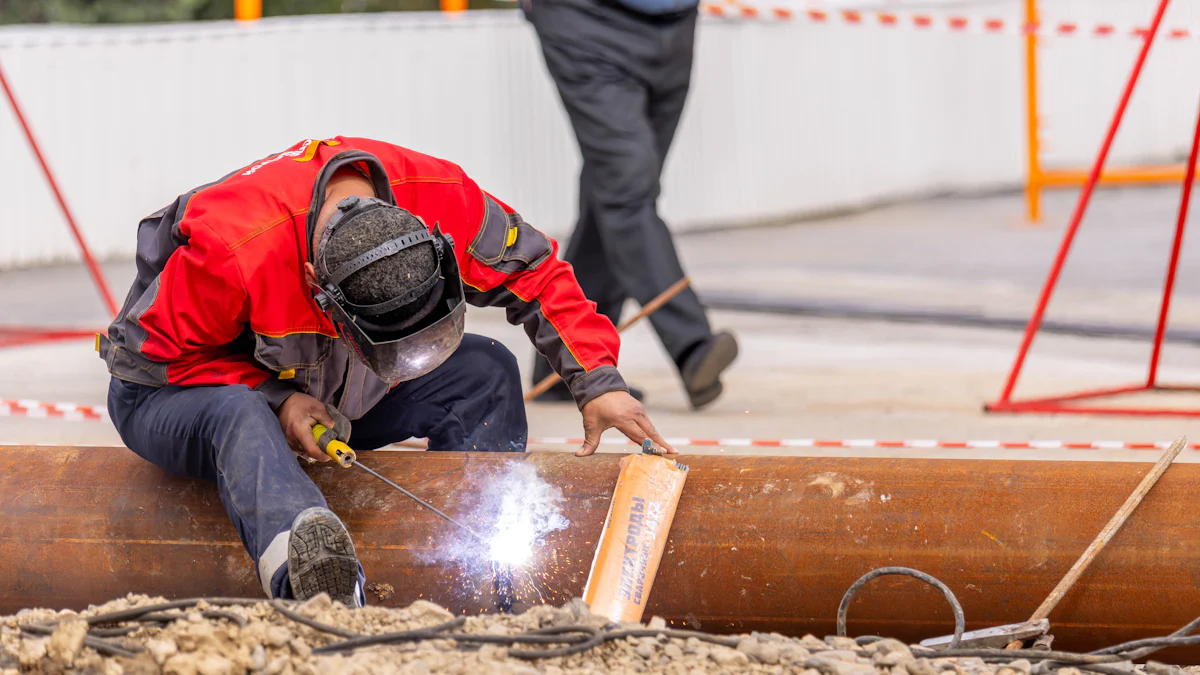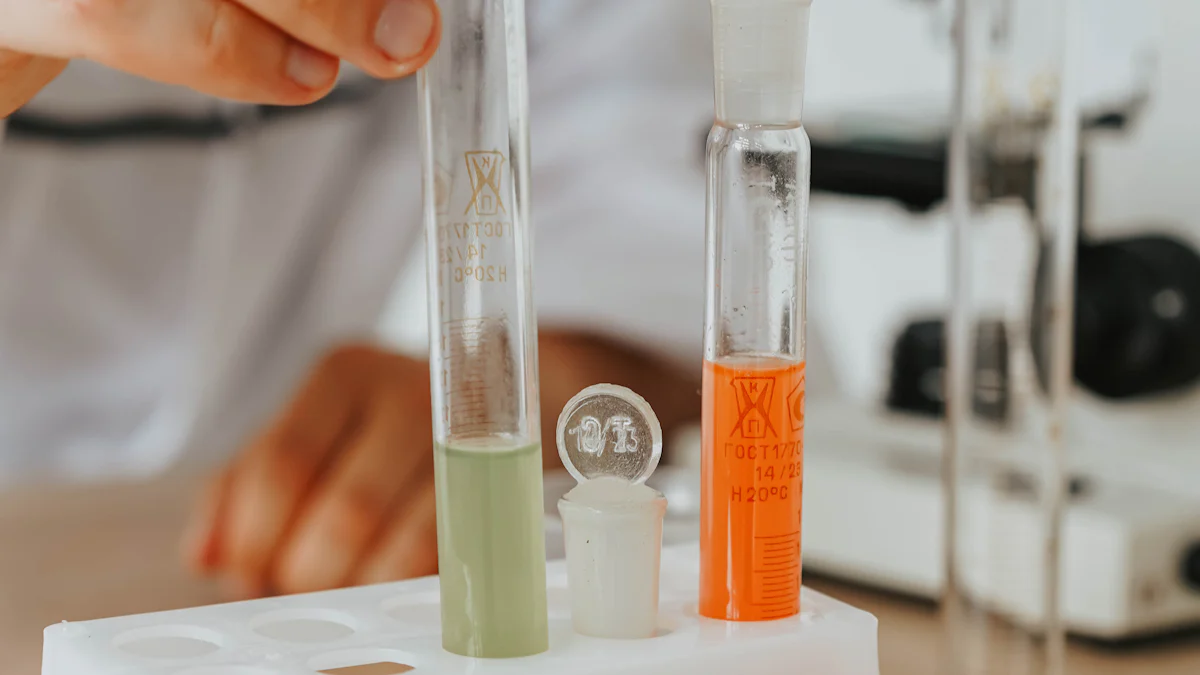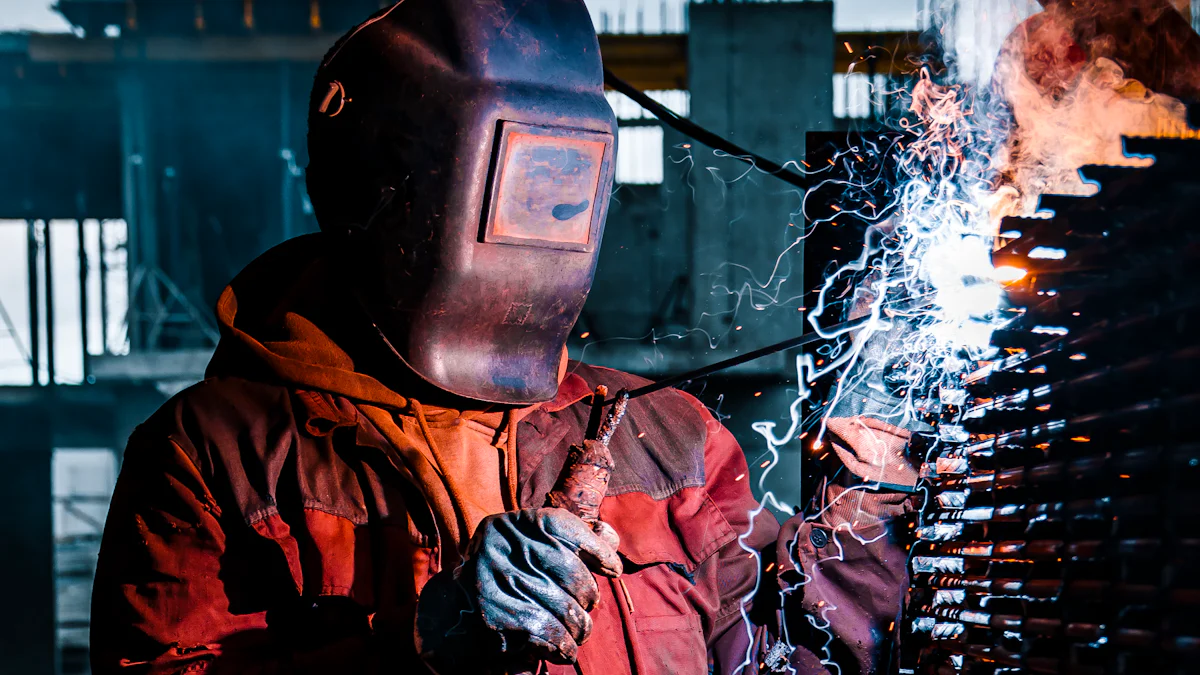
Silicon carbide (SiC) coatings play a pivotal role in enhancing the durability of graphite susceptors, especially in demanding industrial settings. These coatings provide exceptional resistance to corrosion, oxidation, and wear, ensuring long-term stability under extreme conditions. The chemical inertness of SiC prevents reactions with aggressive agents like acids and alkalis, while its thermal stability allows it to withstand high temperatures without degradation. Industries such as semiconductor manufacturing and chemical processing rely on the superior performance of SiC-coated graphite susceptors, including the widely used cvd sic coating susceptor, to maintain efficiency and reliability in harsh environments.
Key Takeaways
SiC coatings enhance the durability, providing exceptional resistance to corrosion, oxidation, and wear in harsh industrial environments.
- The chemical inertness of SiC prevents reactions with aggressive agents, ensuring the underlying graphite remains protected and reducing contamination risks.
- SiC coatings excel in thermal stability, allowing them to withstand extreme temperatures and rapid temperature changes without degrading.
- The hardness and mechanical strength of SiC coatings improve the resilience of graphite susceptors, enabling them to resist wear and extend equipment lifespan.
CVD SiC coating susceptors are essential in industries like semiconductor manufacturing and chemical processing, ensuring efficiency and reliability under demanding conditions.
- Investing in SiC-coated graphite susceptors can lead to significant cost savings by reducing maintenance needs and equipment downtime.
- The unique properties of SiC-coated graphite susceptors make them a preferred choice across various sectors, including aerospace and energy, due to their performance in extreme environments.
Properties of SiC Coatings and Their Role in Corrosion Resistance

Silicon carbide (SiC) coatings possess unique properties that make them indispensable for protecting graphite susceptors in harsh environments. These properties enhance the material’s ability to resist corrosion, maintain structural integrity, and perform reliably under extreme conditions.
Chemical Purity and Inertness
The non-reactive nature of SiC coatings prevents it from interacting with aggressive chemicals such as acids, alkalis, and salts.
Research highlights that SiC coatings effectively resist chemical reactions, making them ideal for applications in semiconductor manufacturing and chemical processing industries. Their ability to maintain purity reduces contamination risks, a crucial factor in sensitive industrial processes.
The chemical inertness of SiC also contributes to its long-term durability. Unlike uncoated materials, SiC-coated graphite susceptors do not degrade when exposed to corrosive agents, ensuring consistent performance over time.
Thermal Conductivity and Stability
SiC coatings excel in thermal conductivity and stability, enabling them to withstand extreme temperatures without compromising their structural integrity. This property is particularly important in high-temperature environments, where materials often face thermal stress and degradation.
Studies emphasize that SiC coatings provide superior thermal stability, allowing them to endure rapid temperature changes and resist thermal shock. This makes them suitable for applications in high-temperature furnaces and aerospace industries.
The high thermal conductivity of SiC ensures efficient heat transfer, which is essential for processes requiring precise temperature control. For instance, in semiconductor manufacturing, SiC-coated graphite susceptors facilitate uniform heating, improving the quality and efficiency of production.
Hardness and Mechanical Strength
The hardness and mechanical strength of SiC coatings play a vital role in enhancing the durability of graphite susceptors. SiC ranks high on the Mohs scale of hardness, making it resistant to wear and abrasion. This property is crucial for applications involving mechanical stress or abrasive conditions.
According to industry reports, SiC coatings improve the resilience of graphite susceptors, enabling them to withstand mechanical impacts and maintain their structural integrity. This durability reduces maintenance requirements and extends the lifespan of the equipment.
The mechanical strength of SiC also contributes to its ability to resist cracking and chipping, even under high-pressure conditions. This ensures that the coating remains intact, providing continuous protection against corrosion and wear.
Performance of CVD SiC Coating Susceptors in Harsh Environments
CVD SiC coating susceptors demonstrate exceptional performance in challenging environments, making them indispensable for industries requiring durability and reliability. Their ability to withstand extreme conditions stems from their unique properties, which ensure consistent functionality even under the harshest circumstances.
High-Temperature Environments
CVD SiC coating susceptors excel in high-temperature environments due to their remarkable thermal stability. The silicon carbide layer resists thermal degradation, maintaining its structural integrity even at elevated temperatures. This makes it a preferred choice for applications such as semiconductor manufacturing and high-temperature furnaces.
Studies reveal that CVD SiC coatings outperform other materials in extreme heat, offering superior thermal conductivity and resistance to thermal shock. These attributes enable efficient heat transfer and uniform temperature distribution, critical for precision-driven processes.
Industries like aerospace and automotive benefit significantly from this capability. The ability of CVD SiC coating susceptors to endure rapid temperature fluctuations ensures reliability in demanding applications, reducing the risk of material failure.
Chemical Corrosive Environments
In chemically aggressive settings, CVD SiC coating susceptors provide unmatched protection. The chemical inertness of silicon carbide prevents reactions with corrosive agents such as acids, alkalis, and salts. This resistance safeguards the underlying graphite, ensuring long-term stability.
Comparative analysis highlights that CVD SiC coatings deliver superior chemical resistance compared to alternative materials. Their ability to withstand harsh chemicals makes them essential for chemical processing industries and semiconductor fabrication.
The non-reactive nature of these coatings minimizes contamination risks, a critical factor in sensitive industrial processes. By maintaining purity and structural integrity, CVD SiC coating susceptors enhance operational efficiency and reduce maintenance requirements.
Oxidative Conditions
Oxidative environments pose significant challenges for many materials, but CVD SiC coating susceptors exhibit exceptional resistance to oxidation. The silicon carbide layer acts as a protective barrier, preventing the oxidation of the graphite substrate even at high temperatures.
Research indicates that CVD SiC coatings outperform other coatings in oxidative conditions, ensuring prolonged durability and consistent performance. This makes them a reliable choice for industries like solar cell manufacturing and LED production.
The oxidation resistance of CVD SiC coating susceptors reduces wear and extends their lifespan. This durability translates to cost savings for industries by minimizing equipment replacement and downtime.
Advantages of SiC-Coated Graphite Susceptors in Industrial Applications

Silicon carbide (SiC)-coated graphite susceptors have become indispensable in various industrial applications due to their exceptional thermal stability, chemical resistance, and mechanical durability. These attributes make them a preferred choice for industries that demand high performance and reliability under extreme conditions.
Applications in Semiconductor Manufacturing
In semiconductor manufacturing, SiC-coated graphite susceptors play a critical role in ensuring process efficiency and product quality. Their ability to maintain thermal stability and uniformity is essential for the growth of epitaxial materials in Metal-Organic Chemical Vapor Deposition (MOCVD) equipment. This precision ensures consistent layer deposition, which is vital for producing high-quality semiconductors.
"SiC-coated graphite susceptors are crucial for the growth quality of epitaxial materials in MOCVD equipment," as highlighted in industry reports. Their resistance to thermal shock and high-temperature degradation enhances the reliability of semiconductor production processes.
Additionally, these susceptors minimize contamination risks due to their chemical inertness. This feature is particularly important in semiconductor fabrication, where even minor impurities can compromise the functionality of the final product. By providing a stable and clean environment, SiC-coated graphite susceptors contribute to the production of advanced electronic components.
Use in High-Temperature Furnaces
High-temperature furnaces rely on SiC-coated graphite susceptors for their ability to withstand extreme heat without losing structural integrity. The SiC coating enhances thermal conductivity, ensuring efficient heat transfer and uniform temperature distribution within the furnace. This capability is critical for processes such as sintering, annealing, and crystal growth.
Studies have shown that SiC coatings provide superior thermal stability, enabling susceptors to endure rapid temperature changes without cracking or degrading. This resilience reduces maintenance needs and extends the operational lifespan of furnace components.
Industries such as aerospace and energy benefit significantly from this application. The use of SiC-coated graphite susceptors in high-temperature environments ensures consistent performance, even under demanding conditions. Their durability translates to cost savings by reducing equipment downtime and replacement frequency.
Benefits in Chemical Processing Industries
Chemical processing industries often operate in environments with highly corrosive agents, making SiC-coated graphite susceptors an ideal choice. The chemical inertness of the SiC layer protects the underlying graphite from acids, alkalis, and salts, ensuring long-term stability and reliability.
Comparative analyses highlight the unmatched chemical resistance of SiC-coated susceptors, making them indispensable for applications involving aggressive chemicals. Their ability to maintain structural integrity under such conditions enhances operational efficiency and reduces contamination risks.
In addition to corrosion resistance, these susceptors offer excellent thermal conductivity, which is crucial for processes requiring precise temperature control. For example, in the production of specialty chemicals, SiC-coated graphite susceptors ensure consistent heating, improving product quality and process efficiency.
The versatility of these susceptors extends to other industries, including LED and solar cell manufacturing. Their ability to perform reliably in chemically aggressive and high-temperature environments makes them a valuable asset across various sectors.
Silicon carbide (SiC) coatings have proven indispensable in enhancing the corrosion resistance of graphite susceptors. Their chemical inertness and oxidation resistance ensure reliable performance in harsh environments, including high-temperature and chemically aggressive conditions. The ability of SiC coatings to withstand extreme heat, resist wear, and maintain thermal conductivity makes them ideal for applications such as furnaces, aerospace, and semiconductor manufacturing. By offering durability and efficiency, components like the cvd sic coating susceptor have become essential for industries requiring robust solutions under demanding conditions.
FAQ
What are SiC-coated graphite susceptors used for in the semiconductor industry?
SiC-coated graphite susceptors serve a critical role in the semiconductor industry, particularly in Metal-Organic Chemical Vapor Deposition (MOCVD) equipment. These SiC-coated graphite susceptors support and heat single-crystal substrates during the epitaxial growth process.
Key Insight: The uniformity provided by SiC-coated graphite susceptors directly impacts the performance and reliability of semiconductor components.
What does the phrase "SiC-coated" refer to?
The term "SiC-coated" describes the application of a silicon carbide (SiC) layer onto the surface of graphite. SiC, a ceramic material, is renowned for its exceptional thermal conductivity, chemical inertness, and mechanical strength. This coating enhances the durability and performance of graphite, making it suitable for use in harsh industrial environments.
Did You Know? SiC coatings not only improve corrosion resistance but also enhance the thermal and mechanical properties of graphite substrates.
Why is SiC coating important for graphite susceptors?
SiC coating is vital for protecting graphite susceptors from oxidation, corrosion, and wear. The silicon carbide layer acts as a barrier, preventing chemical reactions with aggressive agents like acids and alkalis. This protection ensures the long-term stability and reliability of the susceptors, even in extreme conditions.
Pro Tip: Industries that operate in high-temperature or chemically aggressive environments benefit significantly from the enhanced durability of SiC-coated graphite susceptors.
What are the major applications of SiC-coated graphite?
The primary application of SiC-coated graphite lies in the production of susceptors. These susceptors are widely used in industries such as semiconductor manufacturing, high-temperature furnaces, and chemical processing. Additionally, SiC-coated graphite plays a role in microwave production, where the demand continues to grow rapidly.
Industry Insight: The versatility of SiC-coated graphite makes it indispensable across various sectors, including aerospace and energy.
How does SiC coating improve thermal performance?
SiC coatings enhance thermal performance by providing excellent thermal conductivity and stability. This allows the coated graphite to withstand extreme temperatures without degrading. The efficient heat transfer enabled by SiC coatings ensures uniform temperature distribution, which is crucial for precision-driven processes like semiconductor fabrication.
Fact: Studies show that SiC-coated graphite susceptors excel in maintaining structural integrity under rapid temperature changes, reducing the risk of thermal shock.
Can SiC-coated graphite susceptors resist chemical corrosion?
Yes, SiC-coated graphite susceptors exhibit outstanding resistance to chemical corrosion. The silicon carbide layer prevents reactions with corrosive agents such as acids, alkalis, and salts. This chemical inertness ensures the longevity and reliability of the susceptors in chemically aggressive environments.
Expert Opinion: The unmatched chemical resistance of SiC coatings makes them a preferred choice for industries requiring high purity and contamination-free processes.
What industries benefit the most from SiC-coated graphite susceptors?
Industries such as semiconductor manufacturing, chemical processing, aerospace, and energy benefit significantly from SiC-coated graphite susceptors. Their ability to perform reliably in high-temperature, oxidative, and chemically aggressive environments makes them a valuable asset for these sectors.
Highlight: The adoption of SiC-coated graphite susceptors has revolutionized processes in industries that demand precision, durability, and efficiency.
How do SiC-coated graphite susceptors reduce maintenance costs?
The durability of SiC-coated graphite susceptors minimizes wear and tear, reducing the frequency of maintenance and replacement. Their resistance to oxidation, corrosion, and mechanical stress ensures prolonged operational life, translating to cost savings for industries.
Takeaway: Investing in SiC-coated graphite susceptors leads to long-term economic benefits by lowering downtime and maintenance expenses.
Are SiC-coated graphite susceptors environmentally friendly?
SiC-coated graphite susceptors contribute to environmental sustainability by reducing material waste and energy consumption. Their long lifespan and efficiency in heat transfer lower the overall resource usage in industrial processes.
Sustainability Note: By enhancing the durability of equipment, SiC coatings support eco-friendly practices in manufacturing and processing industries.
What makes SiC-coated graphite susceptors unique compared to other materials?
SiC-coated graphite susceptors stand out due to their combination of thermal stability, chemical resistance, and mechanical strength. Unlike uncoated materials, they maintain performance under extreme conditions, ensuring reliability and efficiency in demanding applications.
Conclusion: The unique properties of SiC-coated graphite susceptors make them an indispensable solution for industries operating in harsh environments.